General Sir John Monash, Personal Files Book 17, 1 November 1917 - 13 January 1918, Part 2
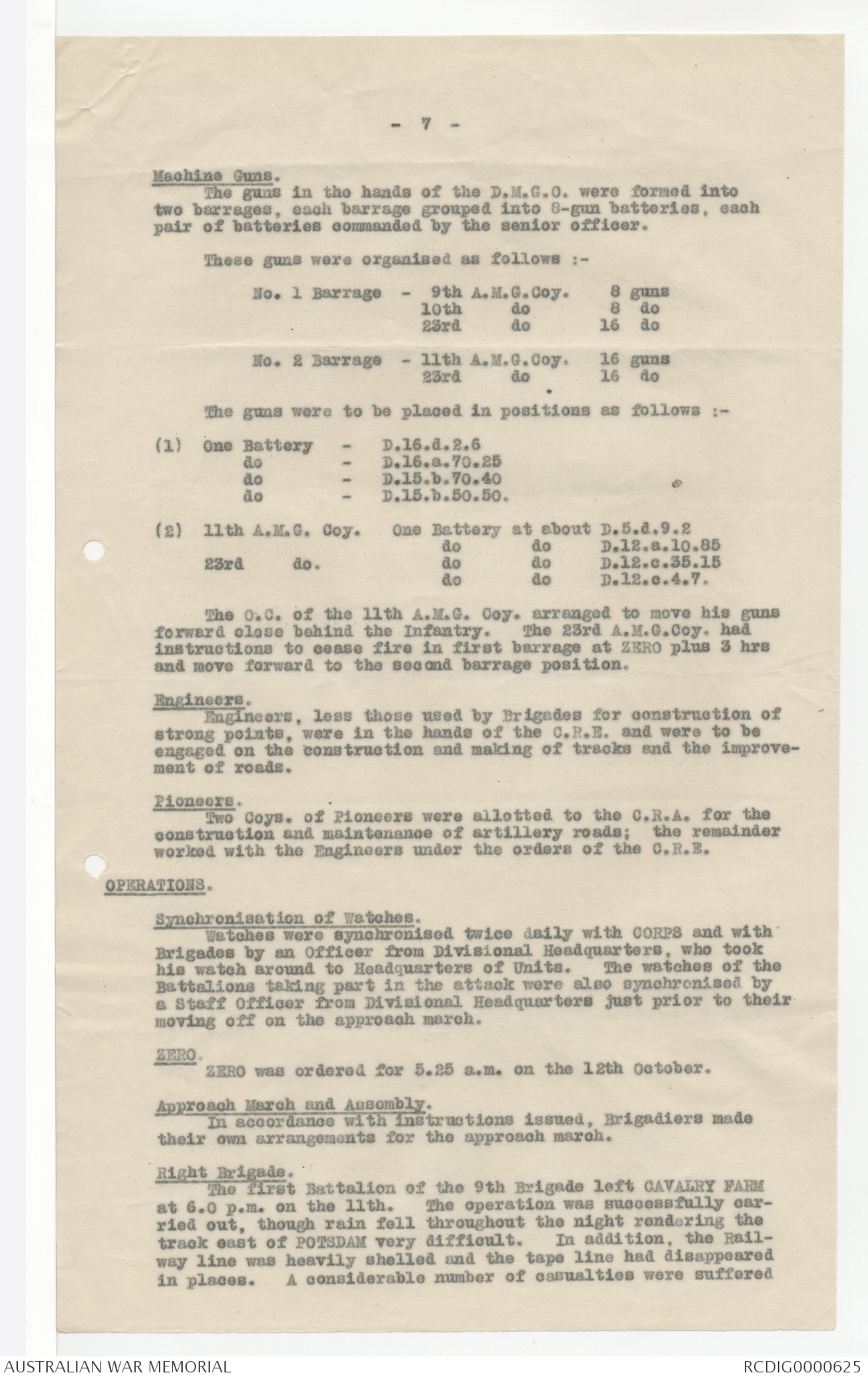
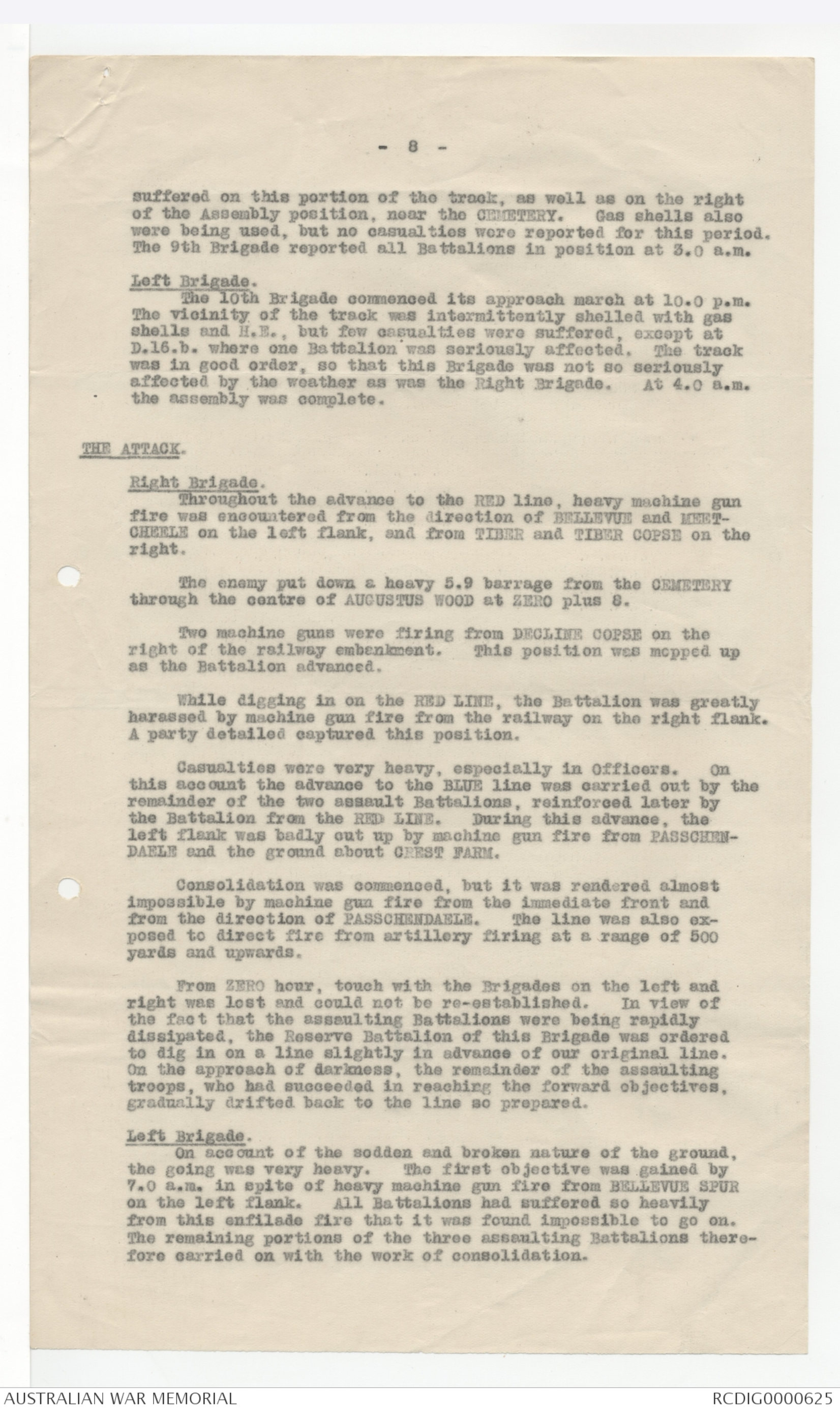

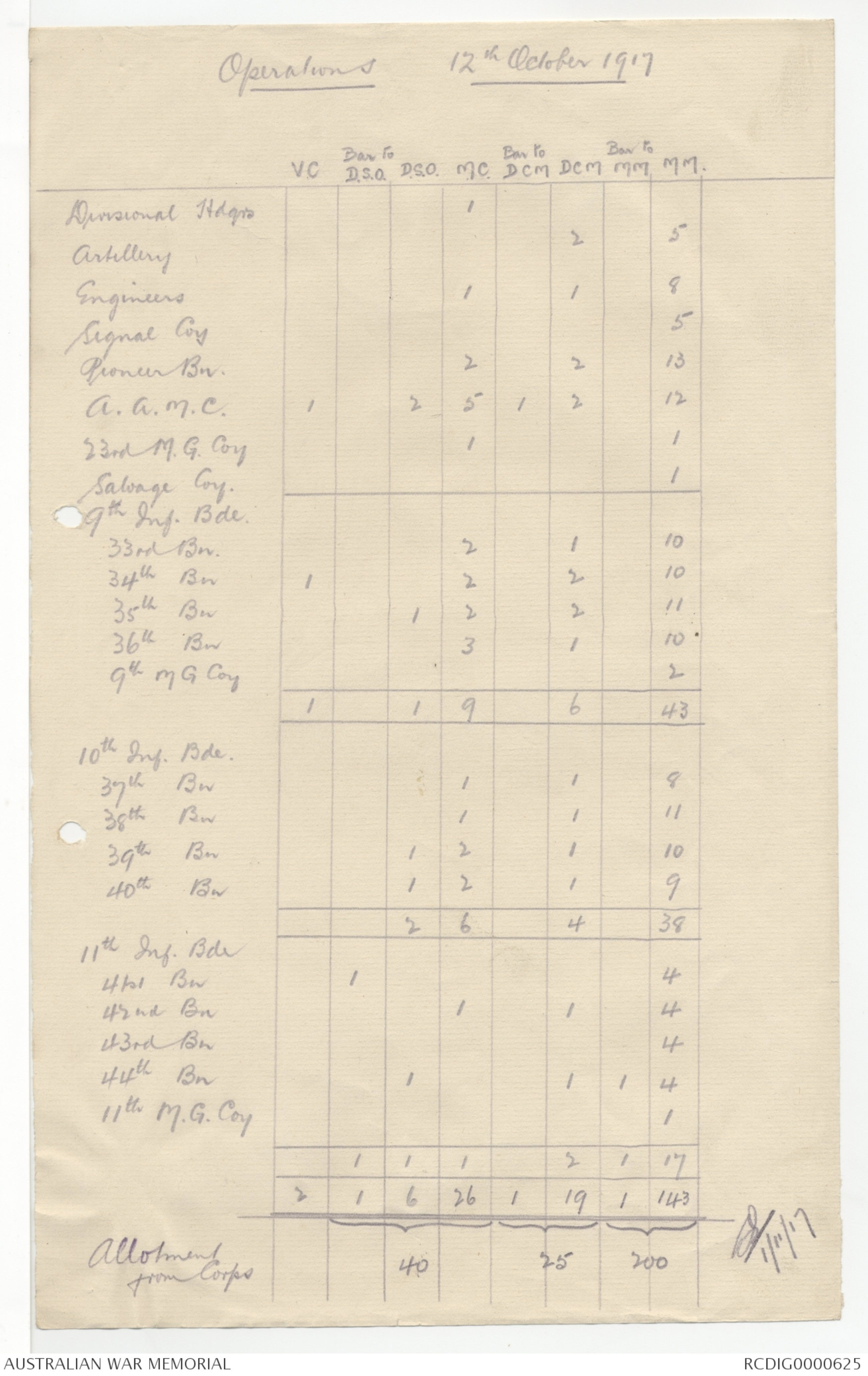
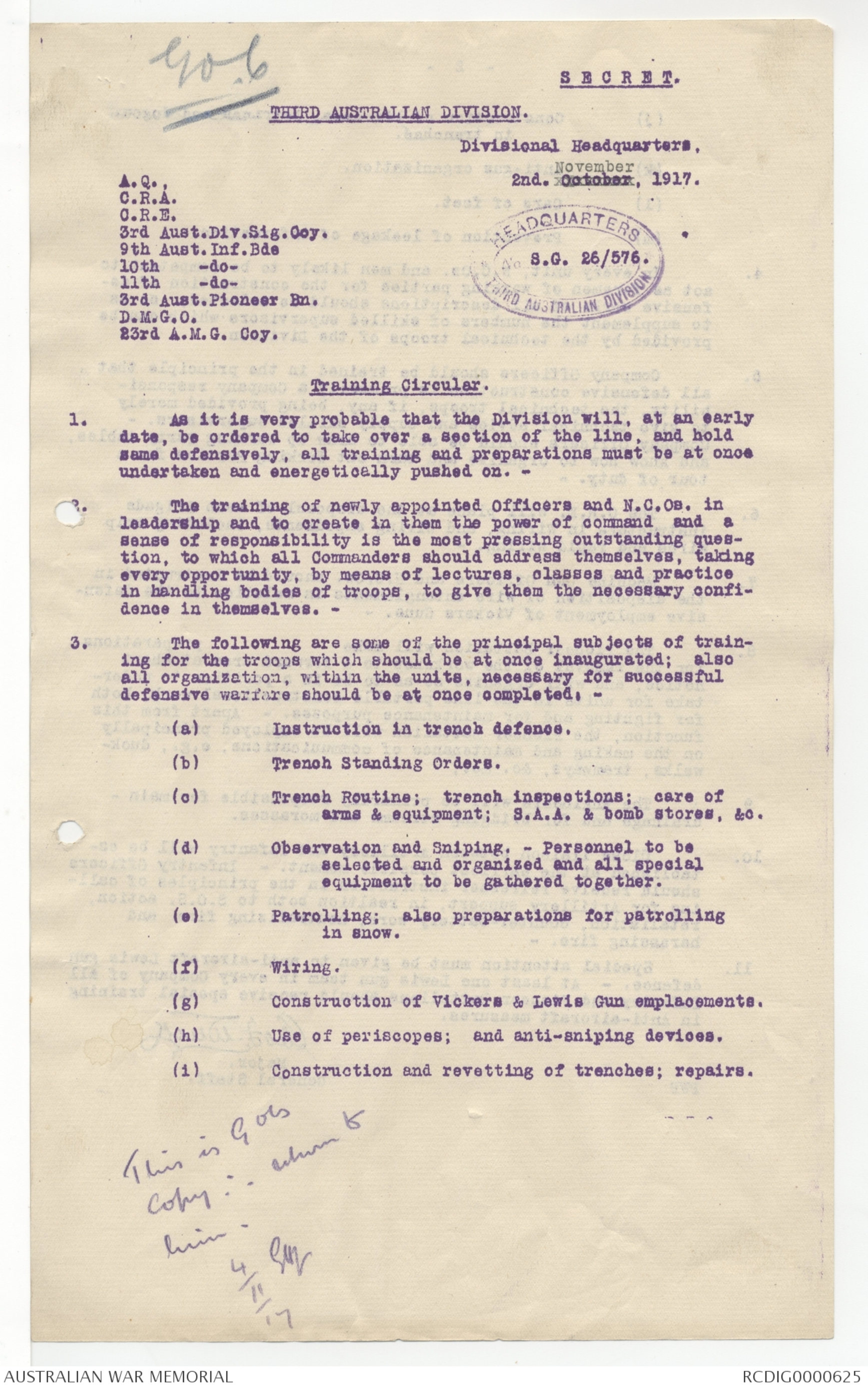
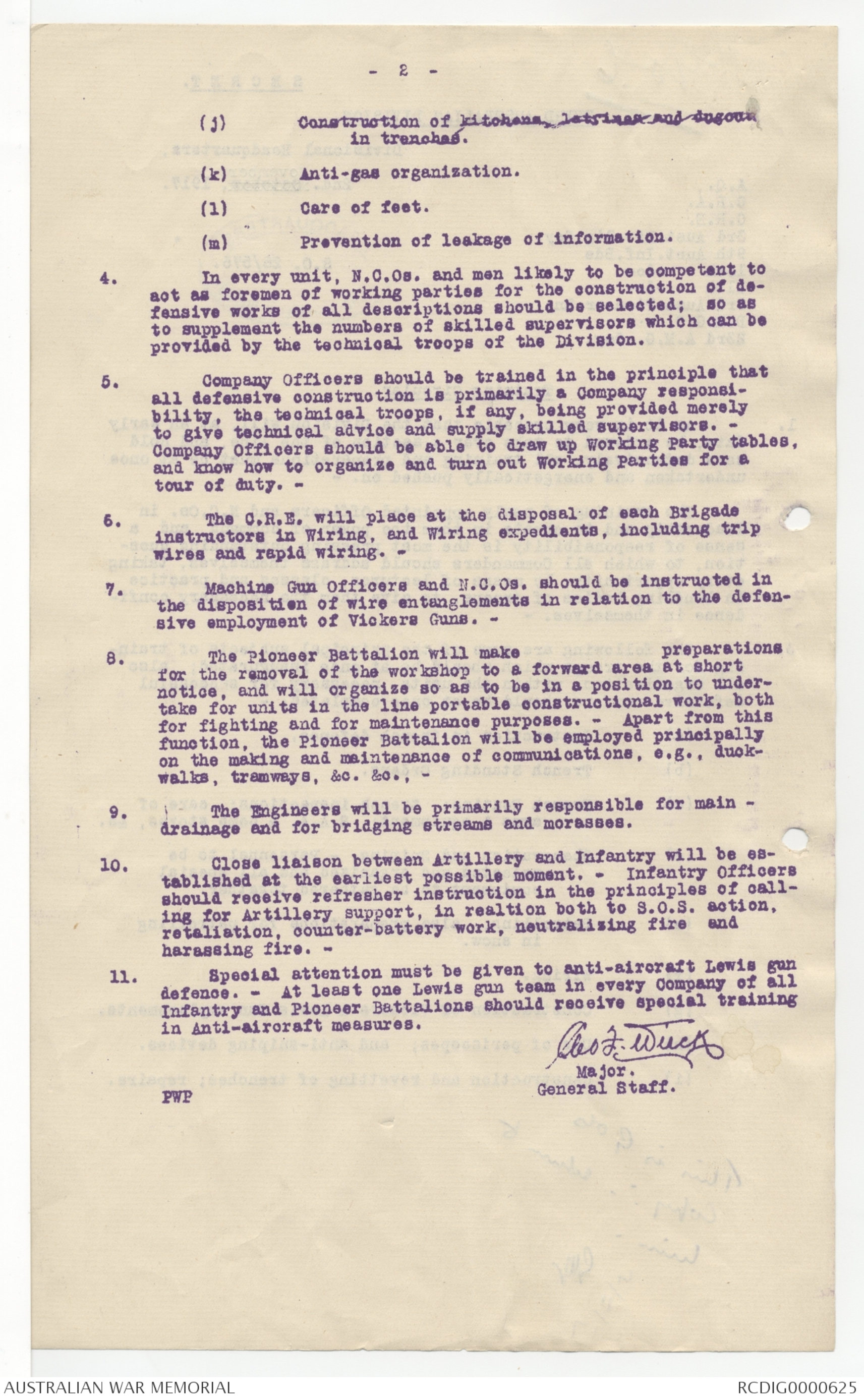
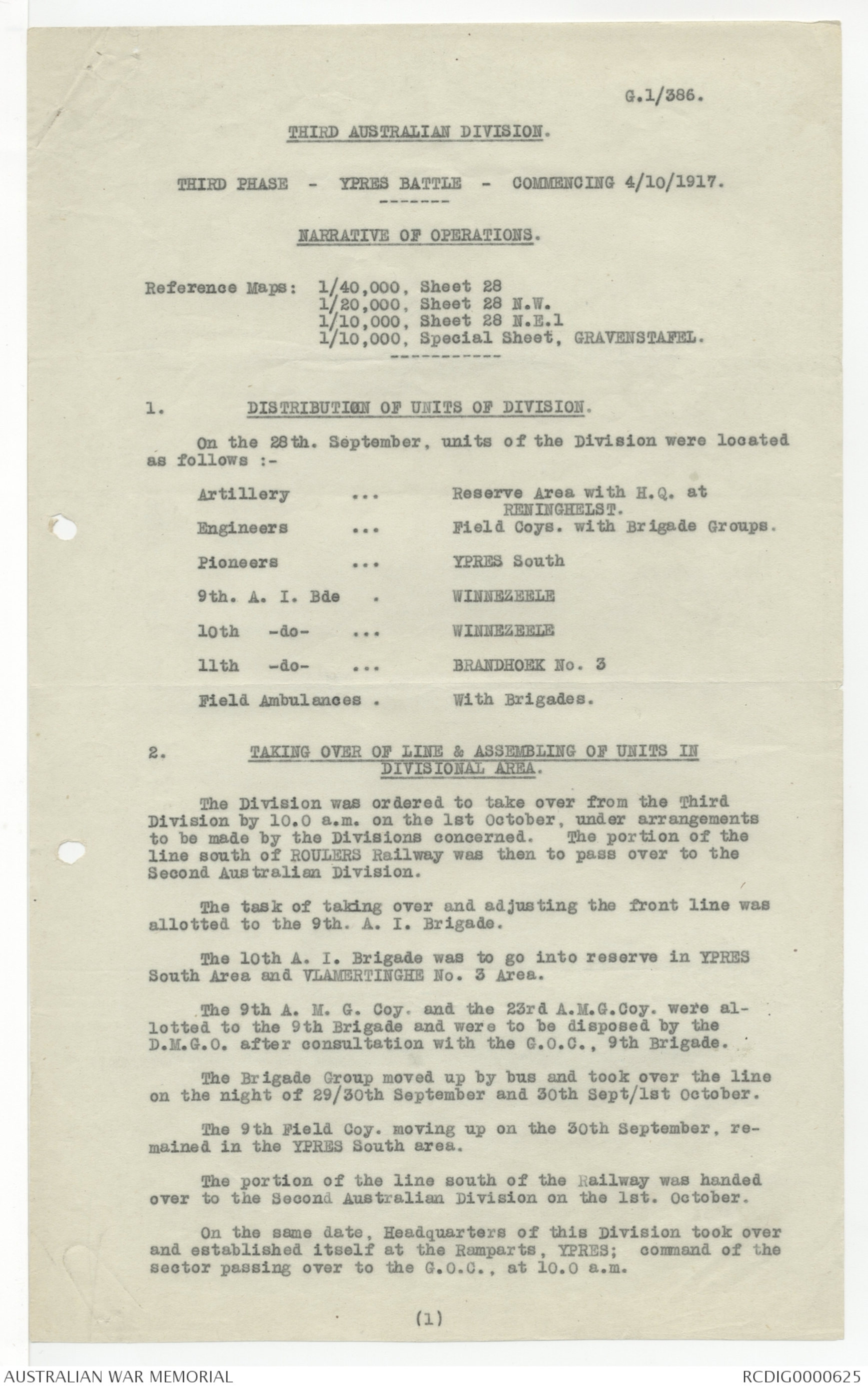
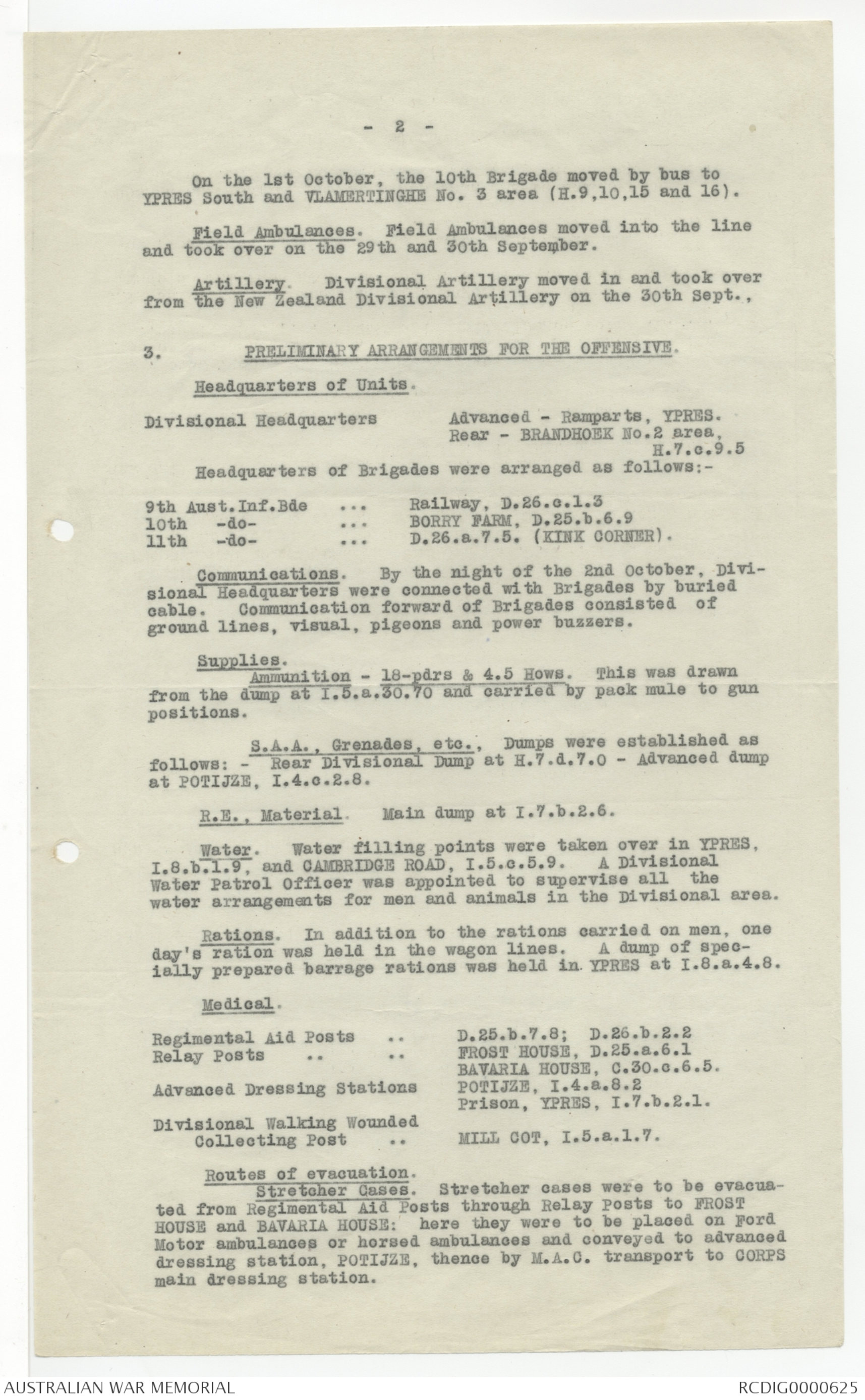
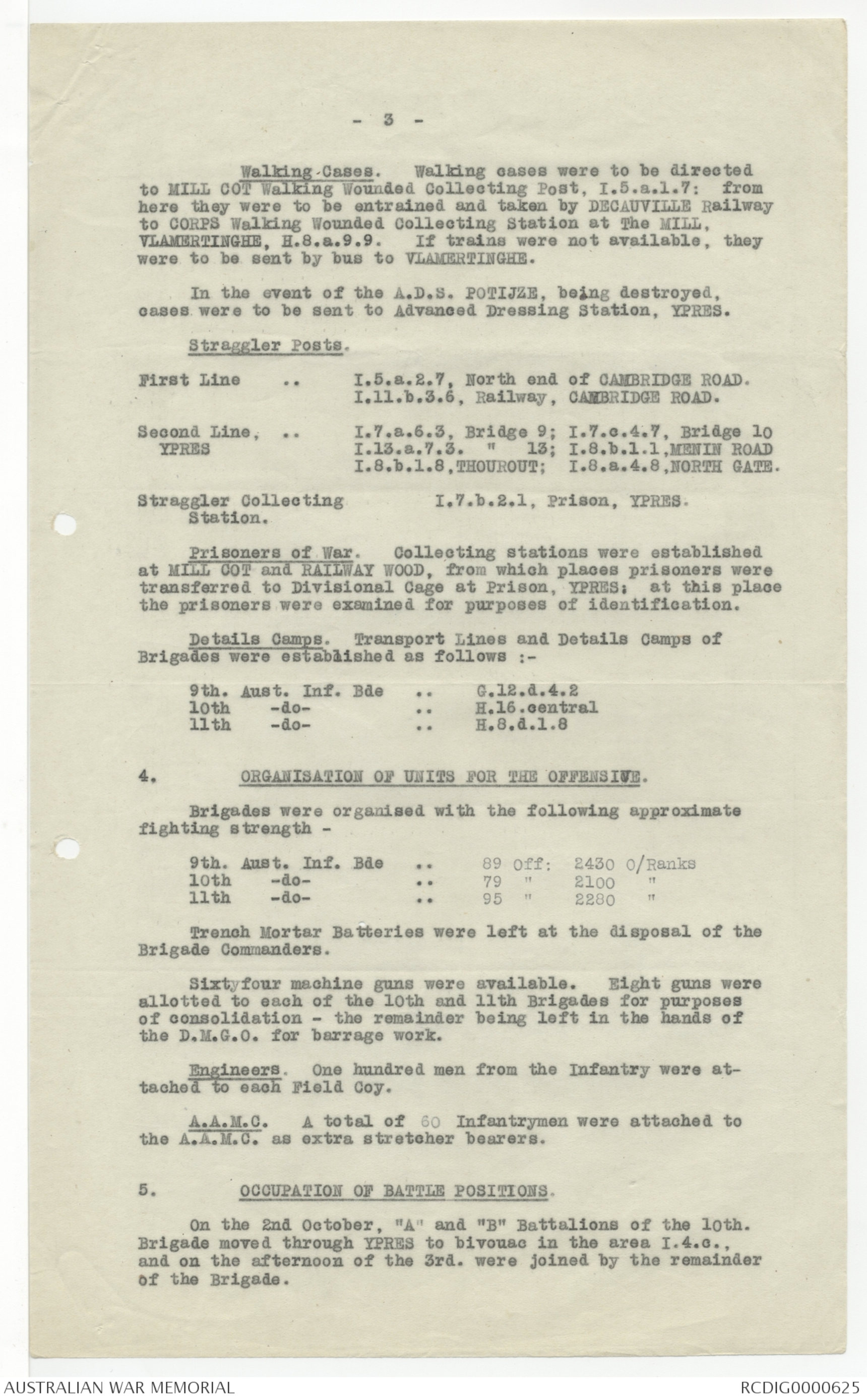
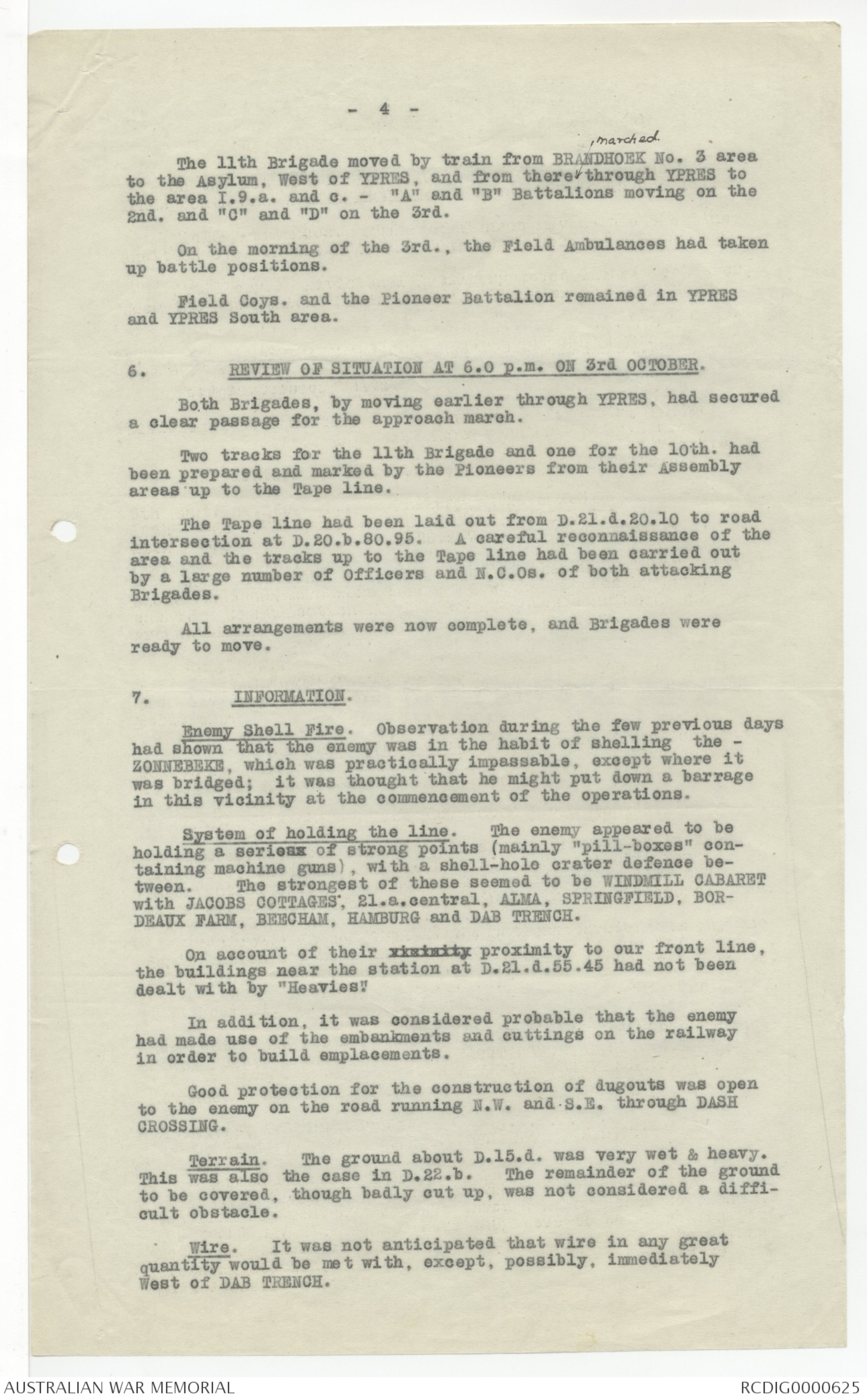
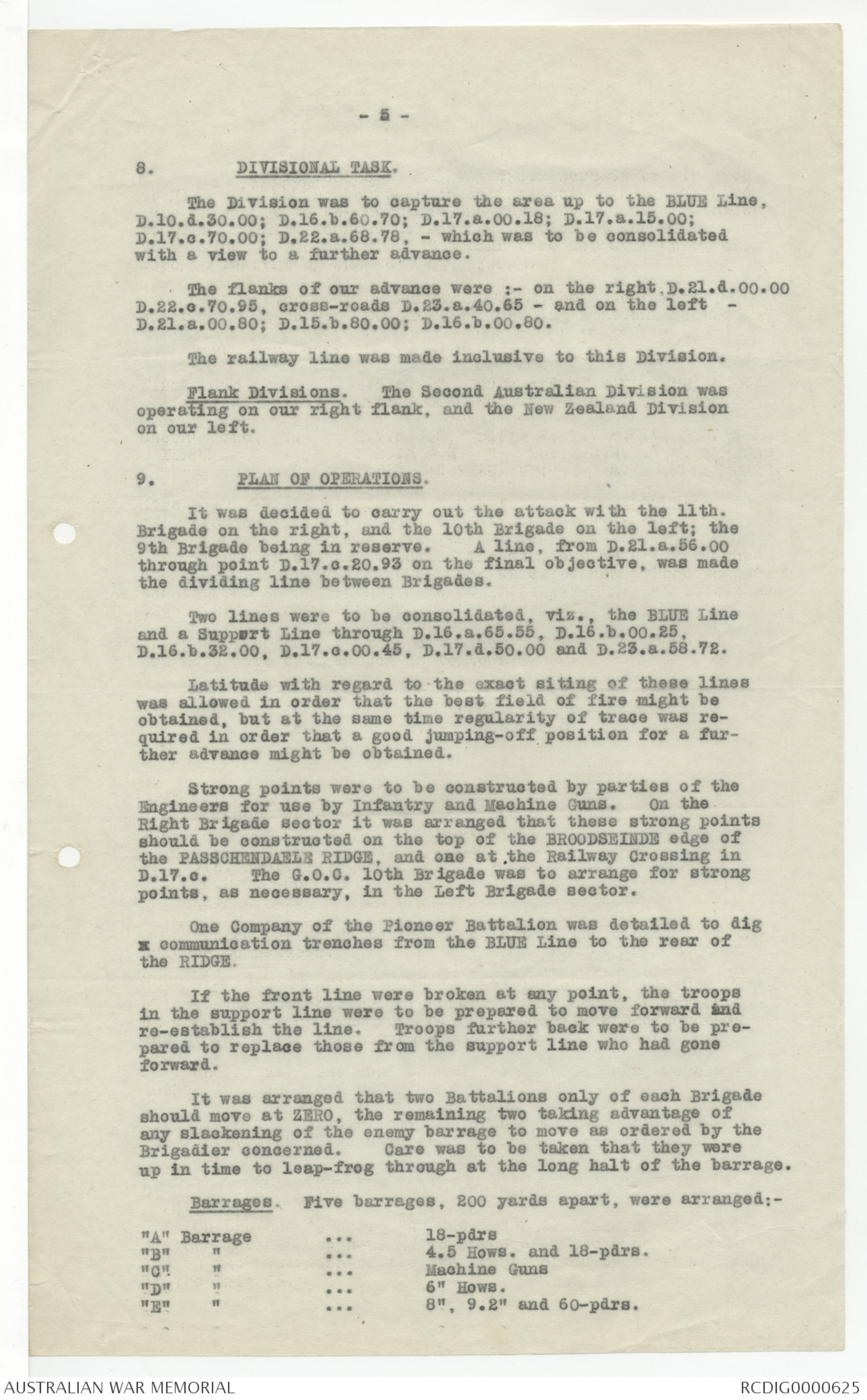
-7 -
Machine Guns.
The guns in the hands of the D.M.G.O. were formed into
two barrages, each barrage grouped into 8-gun batteries, each
pair of batteries commanded by the senior officer.
These guns were organised as follows :-
| No. 1 Barrage - | 9th A.M.G.Coy. | 8 guns |
| 10th do | 8 do | |
| 23rd do | 16 do | |
| No. 2 Barrage - | 11th A.M.G.Coy. | 16 guns |
| 23rd do | 16 do |
The guns were to be placed in positions as follows :-
(1) One Battery - D.16.d.2.6
do - D.16.a.70.25
do - D.15.b.70.40
do - D.15.b.50.50.
(2) 11th A.M.G. Coy. One Battery at about D.5.d.9.2
do do D.12.a.10.85
23rd do. do do D.12.c.35.15
do do D.12.c.4.7
The O.C. of the 11th A.M.G. Coy. arranged to move his guns
forward close behind the Infantry. The 23rd A.M.G.Coy. had
instructions to cease fire in first barrage at ZERO plus 3 hrs
and move forward to the second barrage position.
Engineers.
Engineers, less those used by Brigades for construction of
strong points, were in the hands of the C.R.E. and were to be
engaged on the construction and making of tracks and the improvement
of roads.
Pioneers.
Two Coys. of Pioneers were allotted to the C.R.A. for the
construction and maintenance of artillery roads; the remainder
worked with the Engineers under the orders of the C.R.E.
OPERATIONS.
Synchronisation of Watches.
Watches were synchronised twice daily with CORPS and with
Brigades by an Officer from Divisional Headquarters, who took
his watch around to Headquarters of Units. The watches of the
Battalions taking part in the attack were also synchronised by
a Staff Officer from Divisional Headquarters just prior to their
moving off on the approach march.
ZERO.
ZERO was ordered for 5.25 a.m. on the 12th October.
Approach March and Assembly.
In accordance with instructions issued, Brigadiers made
their own arrangements for the approach march.
Right Brigade.
The first Battalion of the 9th Brigade left CAVALRY FARM
at 6.0 p.m. on the 11th. The operation was successfully carried
out, though rain fell throughout the night rendering the
track east of POTSDAM very difficult. In addition, the Railway
line was heavily shelled and the tape line had disappeared
in places. A considerable number of casualties were suffered.
- 8-
suffered on this portion of the track, as well as on the right
of the Assembly position, near the CEMETERY. Gas shells also
were being used, but no casualties were reported for this period.
The 9th Brigade reported all Battalions in position at 3.0 a.m.
Left Brigade.
The 10th Brigade commenced its approach march at 10.0 p.m.
The vicinity of the track was intermittently shelled with gas
shells and H.E., but few casualties were suffered, except at
D.16.b. where one Battalion was seriously affected. The track
was in good order, so that this Brigade was not so seriously
affected by the weather as was the Right Brigade. At 4.0 a.m.
the assembly was complete.
THE ATTACK.
Right Brigade.
Throughout the advance to the RED line, heavy machine gun
fire was encountered from the the direction of BELLVUE and MEETCHEELE
on the left flank, and from TIBER and TIBER COPSE on the
right.
The enemy put down a heavy 5.9 barrage from the CEMETERY
through the centre of AUGUSTUS WOOD at ZERO plus 8.
Two machine guns were firing from DECLINE COPSE on the
right of the railway embankment. This position was mopped up
as the Battalion advanced.
While digging in on the RED LINE, the Battalion was greatly
harassed by machine gun fire from the railway on the right flank.
A party detailed captured this position.
Casualties were very heavy, especially in Officers. On
this account the advance to the BLUE line was carried out by the
remainder of the two assault Battalions, reinforced later by
the Battalion from the RED LINE. During this advance, the
left flank was badly cut up by machine gun fire from PASSCHENDAELE
and the ground about CREST FARM.
Consolidation was commenced, but it was rendered almost
impossible by machine gun fire from the immediate front and
from the direction of PASSCHENDAELE. The line was also exposed
to direct fire from artillery firing at a range of 500
yards and upwards.
From ZERO hour, touch with the Brigades on the left and
right was lost and could not be re-established. In view of
the fact that the assaulting Battalions were being rapidly
dissipated, the Reserve Battalion of this Brigade was ordered
to dig in on a line slightly in advance of our original line.
On the approach of darkness, the remainder of the assaulting
troops, who had succeeded in reaching the forward objectives,
gradually drifted back to the line so prepared.
Left Brigade.
On account of the sodden and broken nature of the ground,
the going was very heavy. The first objective was gained by
7.0 a.m. in spite of heavy machine gun fire from BELLVUE SPUR
on the left flank. All Battalions had suffered so heavily
from this enfilade fire that it was found impossible to go on.
The remaining portions of the three assaulting Battalions therefore
carried on with the work of consolidation.
-9 -
As the Division on their left had not advanced, touch could
not be obtained, and when later in the day the enemy appeared to
be working in behind their left flank, along BELLEVUE SPUR, the
surviving Officers, after consultation, decided that the position
then reached, which had no field of fire, could not be maintained.
A line was therefore selected, somewhat in advance of the original
line, to which the remainder of the assaulting troops were systematically
withdrawn in small parties and set to work to consolidate.
Touch was thereby regained with the Left Flank Division.
CASUALTIES.
| Off: | O/R. | ||
| Assaulting Brigades - |
9th A.I. Bde 10th do. |
60 41 |
1308 1053 |
| Reserve Brigade - - | 11th do | 13 | 526 |
|
Total Casualties for Division, for period 11th-21st. October . . |
126 | 3182. |
PRISONERS.
Total prisoners captured by the Division were 16 Officers
and 335 other ranks. The enemy troops captured belonged to the
233rd R.I.R (357th and 358th Pioneer Coys. attached to 233rd
R.I.R.), 449th I.R., 8th JAGER Regiment, including 16th and 24th
JAGER Battalions, and 5th BAVARIAN Reserve Division.
G E N E R A L.
Following are the main features which militated against the
complete success of the operation :-
- The approach march was carried out under most trying
conditions, with the result that the strain told on the troops
even before they reached the Tape line.
2. The initial rate of the barrage, due to the necessary
local adjust previously mentioned, was too fast considering the
marshy broken state of the ground and the inclement weather.
The troops were therefore not able to keep up to the barrage,
with the result that the enemy had time to bring his machine
guns to bear after the barrage had passed over.
3. The barrage was reported by both the Infantry taking
part and by an Aeroplane Observer to be very weak.
4. The failure of the Division on our left to take BELLEVUE
SPUR caused almost the whole of our advancing troops to be
exposed to very enfilading machine gun fire from this
flank.
5. To maintain advantages gained under such conditions,
a great deal depended on leaders. Both Brigades suffered very
heavy casualities in Officers and N.C.Os. from the outset.
(Sgd) S. H. JACKSON, Captain
for Lieut.-Colonel, General Staff
PWF
Operations. 12th October 1917
| V.C. |
Bar to D.S.O. |
D.S.O. | M.C. | Bar to DCM | DCM |
Bar to MM |
MM. | |
| Divisional Hdqrs |
|
|
|
1 |
|
|
|
|
| Artillery |
|
|
|
|
|
2 |
|
5 |
| Engineers |
|
|
|
1 |
|
1 |
|
8 |
| Signal Coy |
|
|
|
|
|
|
|
5 |
| Pioneer Bn. |
|
|
|
2 |
|
2 |
|
13 |
| A.A.M.C. |
1 |
|
2 |
5 |
1 |
2 |
|
12 |
| 23rd M.G. Coy |
|
|
|
1 |
|
|
|
1 |
| Salvage Coy. |
|
|
|
|
|
|
|
1 |
| 9th Inf. Bde. |
|
|
|
|
|
|
|
|
| 33rd Bn. |
|
|
|
2 |
|
1 |
|
10 |
| 34th Bn |
1 |
|
|
2 |
|
2 |
|
10 |
| 35th Bn |
|
|
1 |
2 |
|
2 |
|
11 |
| 36th Bn |
|
|
|
3 |
|
1 |
|
10 |
| 9th M G Coy |
|
|
|
|
|
|
|
2 |
|
1 |
|
1 |
9 |
|
6 |
|
43 |
|
| 10th Inf. Bde. |
|
|
|
|
|
|
|
|
| 37th Bn |
|
|
|
1 |
|
1 |
|
8 |
| 38th Bn |
|
|
|
1 |
|
1 |
|
11 |
| 39th Bn |
|
|
1 |
2 |
|
1 |
|
10 |
| 40th Bn |
|
|
1 |
2 |
|
1 |
|
9 |
|
|
|
2 |
6 |
|
4 |
|
38 |
|
| 11th Inf. Bde |
|
|
|
|
|
|
|
|
| 41st Bn |
|
1 |
|
|
|
|
|
4 |
| 42nd Bn |
|
|
|
1 |
|
1 |
|
4 |
| 43rd Bn |
|
|
|
|
|
|
|
4 |
| 44th Bn | 1 | 1 | 1 | 4 | ||||
| 11th M.G. Coy | 1 | |||||||
| 1 | 1 | 1 | 2 | 1 | 17 | |||
| 2 | 1 | 6 | 26 | 1 | 19 | 1 | 143 | |
|
Allotment from Corps |
{ | 40 | } | { | 25} | { | 200} |
[[?initials]]
1/11/17
GOC
S E C R E T.
THIRD AUSTRALIAN DIVISION.
Divisional Headquarters ,
2nd. October November, 1917.
HEADQUARTERS
S.G. 26/576.
THIRD AUSTRALIAN DIVISION
A.Q.,
C.R.A.
C.R.E.
3rd Aust.Div.Sig.Coy.
9th Aust.Inf.Bde
10th -do-
11th -do-
3rd Aust.Pioneer Bn.
D.M.G.O.
23rd A.M.G. Coy.
Training Circular.
- As it is very probable that the Division will, at an early
date, be ordered to take over a section of the line, and hold
same defensively, all training and preparations must be at once
undertaken and energetically pushed on. -
2. The training of newly appointed Officers and N.C.Os. in
leadership and to create in them the power of command and a
sense of responsibility is the most pressing outstanding question,
to which all Commanders should address themselves, taking
every opportunity, by means of lectures, classes and practice
in handling bodies of troops, to give them the necesary confidence
in themselves. -
3. The following are some of the principal subjects of training
for the troops which should be at once inaugurated; also
all organisation, within the units, necessary for successful
defensive warfare should be at once completed. -
(a) Instruction in trench defence.
(b) Trench Standing Orders.
(c) Trench Routine; trench inspections; care of
arms & equipment; S.A.A. & bomb stores, &c.
(d) Observation and Sniping. - Personnel to be
selected and organized and all special
equipment to be gathered together.
(e) Patrolling; also preparations for patrolling
in snow.
(f) Wiring.
(g) Construction of Vickers & Lewis Gun emplacements.
(h) Use of periscopes; and anti-sniping devices.
(i) Construction and revetting of trenches; repairs.
(*This is GOCs
Copy therefore return to
him.*)
4/11/17 GW
-2-
(j) Construction of kitchens, latrines and dugouts
in trenches.
(k) Anti-gas organization.
(l) Care of feet.
(m) Prevention of leakage of information.
4. In every unit, N.C.Os. and men likely to be competent to
act as foremen of working parties for the construction of defensive
works of all descriptions should be selected; so as
to supplement the numbers of skilled supervisors which can be
provided by the technical troops of the Division.
5. Company Officers should be trained in the principle that
all defensive construction is primarily a Company responsibility,
the technical troops, if any, being provided merely
to give technical advice and supply skilled supervisors. -
Company Officers should be able to draw up Working Party tables,
and know how to organize and turn out Working Parties for a
tour of duty. -
6. The C.R.E. will place at the disposal of each Brigade
instructors in Wiring, and Wiring expedients, including trip
wires and rapid wiring. -
7. Machine Gun Officers and N.C.Os. should be instructed in
the disposition of wire entanglements in relation to the defensive
employment of Vickers Guns. -
8. The Pioneer Battalion will make preparations
for the removal of the workshop to a forward area at short
notice, and will organize so as to be in a position to undertake
for units in the line portable construction work, both
for fighting and for maintenance purposes. - Apart from this
function, the Pioneer Battalion will be employed principally
on the making and maintenance of communications, e.g., duckwalks,
tramways, &c. &c., -
9. The Engineers will be primarily responsible for main -
drainage and for bridging streams and morasses.
10. Close liaison between Artillery and Infantry will be establihsed
at the earliest possible moment. - Infantry Officers
should receive refresher instruction in the principles of calling
for Artillery support, in realtion both to S.O.S. action,
retaliation, counter-battery work, neutralising fire and
harassing fire. -
11. Special attention must be given to anti-aircraft Lewis gun
defence. - At least one Lewis gun team in every Company of all
Infantry and Pioneer Battalions should receive special training
in Anti-aircraft measures.
Geo F. Wieck
Major.
General Staff.
PWP
G.1/386.
THIRD AUSTRALIAN DIVISION.
THIRD PHASE - YPRES BATTLE - COMMENCING 4/10/1917.
- - - - - - - -
NARRATIVE OF OPERATIONS
Reference Maps: 1/40,000, Sheet 28
1/20,000, Sheet 28 N.W.
1/10,000, Sheet 28 N.E.1
1/10,000, Special Sheet, GRAVENSTAFEL.
- - - - - - - -
- DISTRIBUTION OF UNITS OF DIVISION.
On the 28 th. September, units of the Division were located
as follows :-
Artillery . . . Reserve Area with H.Q. at
RENINGHELST.
Engineers . . . Field Coys. with Brigade Groups.
Pioneers . . . YPRES South
9th. A. I. Bde . . . WINNEZEELE
10th -do- . . . WINNEZEELE
11th -do- . . . BRANDHOEK No. 3
Field Ambulances . . . With Brigades.
2. TAKING OVER OF LINE & ASSEMBLING OF UNITS IN
DIVISIONAL AREA.
The Division was ordered to take over from the Third
Division by 10.0 a.m. on the 1st October, under arrangements
to be made by the Divisions concerned. The portion of the
line south of ROULERS Railway was then to pass over to the
Second Australian Division.
The task of taking over and adjusting the front line was
allotted to the 9th. A. I. Brigade.
The 10th A. I. Brigade was to go into reserve in YPRES
South Area and VLAMERTINGHE No. 3 Area.
The 9th A. M. G. Coy. and the 23rd A.M.G.Coy. were allotted
to the 9th Brigade and were to be disposed by the
D.M.G.O. after consultation with the G.O.C., 9th Brigade.
The Brigade Group moved up by bus and took over the line
on the night of 29/30th September and 30th Sept/1st October.
The 9th Field Coy. moving up on the 30th September,
remained in the YPRES South area.
The portion of the line south of the Railway was handed
over to the Second Australian Division on the 1st. October.
On the same date, Headquarters of this Division took over
and established itself at the Ramparts, YPRES; command of
the
sector passing over to the G.O.C., at 10.0 a.m.
( 1 )
-2 -
On the 1st October, the 10th Brigade moved by bus to
YPRES South and VLAMERTINGHE No. 3 area (N.9.10.15 and 16 ).
Field Ambulances. Field Ambulances moved into the line
and took over on the 29th and 30th September.
Artillery. Divisional Artillery moved in and took over
from the New Zealand Divisional Artillery on the 30th Sept.
3. PRELIMINARY ARRANGEMENTS FOR THE OFFENSIVE.
Headquarters of Units.
Divisional Headquarters Advanced - Ramparts, YPRES.
Rear - BRANDHOEK No.2 area.
N.7.c.9.5
Headquarters of Brigades were arranged as follows:-
9th Aust.Inf.Bde Railway, D.26.c.1.3
10th -do- BORRY FARM, D.25.b.6.9
11th -do- D.26.a.7.5. ( KINK CORNER ).
Communications. By the night of the 2nd October,
Divisional Headquarters were connected with Brigades by
buried
cable. Communication forward of Brigades consisted of
ground lines, visual, pigeons and power buzzers.
Supplies.
Ammunition - 18-pdrs & 4.5 Hows. This was drawn
from the dump at I.5.a.30.70 and carried by pack mule to
gun
positions.
S.A.A., Grenades, etc., Dumps were established as
follows: - Rear Divisional Dump at H.7.d.7.0 - Advanced dump
at POTIJZE, I.4.c.2.8.
R.E., Material. Main dump at I.7.b.2.6.
Water. Water filling points were taken over in YPRES.
I.8.b.1.9. and CAMBRIDGE ROAD, I.5.c.5.9. A Divisional
Water Patrol Officer was appointed to supervise all the
water arrangements for men and animals in the Divisional
area.
Rations. In addition to the rations carried on men, one
day's ration was held in the wagon lines. A dump of
specially prepared barrage rations was held in YPRES at
I.8.a.4.8.
Medical.
Regimental Aid Posts . . D.25.b.7.8; D.26.b.2.2
Relay Posts . . . . FROST HOUSE, D.25.a.6.1
BAVARIA HOUSE, C.30.c.6.5.
Advanced Dressing Stations POTIJZE, I.4.a.8.2.
Prison, YPRES, I.7.b..2.1.
Divisional Walking Wounded
Collecting Post . . MILL COT, I.5.a.1.7.
Routes of evacuation.
Stretcher Cases. Stretcher cases were to be evacuated
from Regimental Aid Posts through Relay Posts to FROST
HOUSE and BAVARIA HOUSE: here they were to be placed
on Ford
Motor ambulances or horsed ambulances and conveyed to
advanced
dressing station, POTIJZE, thence by M.A.C. transport to CORPS
main dressing station.
-3-
Walking Cases. Walking cases were to be directed
to MILL COT Walking Wounded Collecting Post, I.5.a.1.7: from
here they were to be entrained and taken by DECAUVILLE
Railway
to CORPS Walking Wounded Collecting Station at The MILL,
VLAMERTINGHE, H.8.a.9.9. If trains were not available, they
were to be sent by bus to VLAMERTINGHE.
In the event of the A.D.S. POTIJZE, being destroyed,
cases were to be sent to Advanced Dressing Station, YPRES.
Straggler Posts.
First Line . . I.5.a.2.7. North end of CAMBRIDGE ROAD.
I.11.b.3.6. Railway, CAMBRIDGE ROAD.
Second Line, . . I.7.a.6.3. Bridge 9: I.7.c.4.7. Bridge 10
YPRES I.13.a.7.3. " 13: I.8.b.1.1. MENIN ROAD
I.8.b.1.8. THOUROUT: I.8.a.4.8. NORTH GATE.
Straggler Collecting I.7.b.2.1. Prison, YPRES.
Station.
Prisoners of War. Collecting stations were established
at MILL COT and RAILWAY ROAD, from which places
prisoners were
transferred to Divisional Cage at Prison, YPRES, at this place
the prisoners were examined for purposes of identification.
Details Camps. Transport Lines and Details Camps of
Brigades were established as follows :-
9th. Aust. Inf. Bde. . . C.12.d.4.2
10th -do- . . H.16.central
11th -do- . . H.8.d.1.8
4. ORGANISATION OF UNITS FOR THE OFFENSIVE.
Brigades were organised with the following approximate
fighting strength -
9th. Aust. Inf. Bde. . . 89 Off: 2430 O/Ranks
10th -do- . . 79 " 2100 "
11th -do- . . 95 " 2280 "
Trench Mortar Batteries were left at the disposal of the
Brigade Commanders.
Sixty four machine guns were available. Eight guns were
allotted to each of the 10th and 11th Brigades for purposes
of consolidation - the remainder being left in the hands of
the D.M.G.O. for barrage work.
Engineers. One hundred men from the Infantry were
attached to each Field Coy.
A.A.M.C. A total of 60 Infantrymen were attached to
the A.A.M.C. as extra stretcher bearers.
5. OCCUPATION OF BATTLE POSITIONS.
On the 2nd October, "A" and "B" Battalions of the 10th.
Brigade moved through YPRES to bivouac in the area I.4.c.,
and on the afternoon of the 3rd. were joined by the remainder
of the Brigade.
-4-
The 11th Brigade moved by train from BRANDHOEK No. 3 area
to the Asylum, West of YPRES, and from there ∧ marched
through YPRES to
the area I.9.a. and c. - "A" and "B" Battalions moving on the
2nd. and "C" on the 3rd.
On the morning of the 3rd., the Field Ambulance had taken
up battle positions.
Field Coys. and the Pioneer Battalion remained in YPRES
and YPRES South area.
6. REVIEW OF SITUATION AT 6.0 p.m. ON 3rd OCTOBER.
Both Brigades, by moving earlier through YPRES, had secured
a clear passage for the approach march.
Two tracks for the 11th Brigade and one for the 10th. had
been prepared and marked by the Pioneers from their
Assembly
areas up to the Tape line.
The Tape line had been laid out from D.21.d.20.10 to read
intersection at D.20.b.80.95. A careful reconnaissance of
the
area and the tracks up to the Tape line had been carried out
by a large number of Officers and N.C.Os. of both attacking
Brigades.
All arrangements were now complete, and Brigades were
ready to move.
7. INFORMATION.
Enemy Shell Fire. Observation during the few previous days
had shown that the enemy was in the habit of shelling the -
ZONNEBEKE, which was practically impassable, except where
it
was thought that he might put down a barrage
in this vicinity at the commencement of the operations.
System of holding the line. The enemy appeared to be
holding a seriesx of strong points (mainly "pill-boxes"
containing machine guns), with a shell-hole crater defence
between. The strongest of these seemed to be WINDMILL
CABARET
with JACOBS COTTAGES, 21.a.central, ALMA, SPRINGFIELD,
BORDEAUX FARM, BEECHAM, HAMBURG and DAB TRENCH.
On account of their vicinity proximity to our front line,
the buildings near the station at D.21.d.55.45 had not been
dealt with by "Heavies".
In addition, it was considered probable that the enemy
had made use of the embankments and cuttings on the
railway
in order to build emplacements.
Good protection for the construction of dugouts was open
to the enemy on the road running N.W. and S.E. through
DASH
CROSSING.
Terrain. The ground about D.15.d. was very wet & heavy.
This was also the case in D.22.b. The remainder of the ground
to be covered, though badly cut up, was not considered a
difficult obstacle.
Wire. It was not anticipated that wire in any great
quantity would be would be met with, except, possibly,
immediately
West of DAB TRENCH.
-5-
8. DIVISIONAL TASK.
The Division was to capture the area up to the BLUE Line,
D.10.d.30.00; D.16.b.60.70; D.17.a.00.18; D.17.a.15.00;
D.17.c.70.00; D.22.a.58.78. - which was to be consolidated
with a view to a further advance.
The flanks of our advance were :- on the right D.21.d.00.00
D.22.c.70.95. cross-roads D.23.a.4065 - and on the left -
D.21.a.00.80; D.15.b.80.00; D.16.b.00.80.
The railway line was made inclusive to this Division.
Flank Divisions. The Second Australian Division was
operating on our right flank, and the New Zealand Division
on our left.
9. PLAN OF OPERATIONS.
It was decided to carry out the attack with the 11th.
Brigade on the right, and the 10th Brigade on the left; the
9th Brigade being in reserve. A line, from D.21.a.56.00
through point D.17.c.20,93 on the final objective, was made
the dividing line between Brigades.
Two lines were to be consolidated, viz., the BLUE Line
and a Support Line through D.16.a.65.55. D.16.b.00.25. D.16.b.32.00. D.17.c.00.45. D.17.d.50.00 and D.23.a.58.72.
Latitude with regard to the exact siting of these lines
was allowed in order that the best field of fire might be
obtained, but at the same time regularity of trace was
required in order that a good jumping-off position for a
further advance might be obtained.
Strong points were to be constructed by parties of the
Engineers for use by Infantry and Machine Guns. On the
Right Brigade sector it was arranged that these strong points
should be constructed on the top of the BROODSEINDE edge
of
the PASSCHENDAELE RIDGE, and one at the Railway Crossing
in
D.17.c. The G.O.C. 10th Brigade was to arrange for strong
points, as necessary, in the Left Brigade sector.
One Company of the Pioneer Battalion was detailed to diga communication trenches from the BLUE Line to the rear of
the RIDGE.
If the front line were broken at any point, the troops
in the support line were to be prepared to move forward and
re-establish the line. Troops further back were to be
prepared to replace those from the support line who had gone
forward.
It was arranged that two Battalions only of each Brigade
should move at ZERO, the remaining two taking advantage
of
any slackening of the enemy barrage to move as ordered by
the
Brigadier concerned. Care was to be taken that they were
up in time to leap-frog through at the long halt of the barrage.
Barrages. Five barrages, 200 yards apart, were arranged:-
"A" Barrage . . . 18-pdrs
"B" " . . . 4.5 Hows. and 15-pdrs.
"C" " . . . Machine Guns
"D" " . . . 6" Hows.
"E" " . . . 8", 9.2" and 60-pdrs.
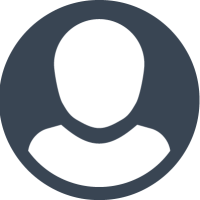 Sandy Mudie
Sandy MudieThis transcription item is now locked to you for editing. To release the lock either Save your changes or Cancel.
This lock will be automatically released after 60 minutes of inactivity.